Bobcat Il-28 1:48
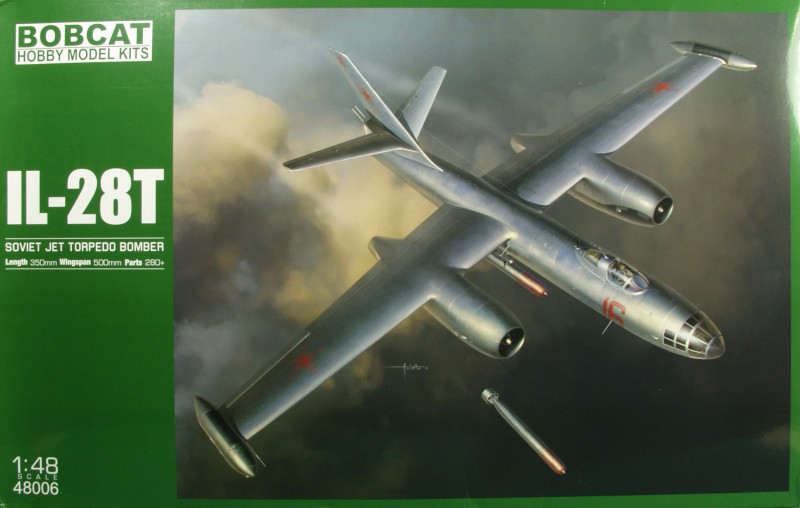
History
(From Wikipedia with some changes)
The Ilyushin Design Bureau began development of a new jet-powered tactical bomber in late 1947. The twin-engine Ilyushin Il-28 was created to meet a requirement for a bomber to carry a 6,600 lb bomb load at 500 mph. The new design took advantage of the sale of a number of Rolls-Royce Nene jet engines by Great Britain to the Soviet Union, which allowed Soviet engineers to quickly produce an unlicensed copy of the Nene, the RD-45, with Ilyushin designing the new bomber around two RD-45s.
The Il-28 was smaller than the previous designs and carried a crew of only three (pilot, navigator and gunner). It was also smaller than the competing design from the Tupolev design bureau, the three-engine (i.e. two Nenes and a Rolls-Royce Derwent) Tupolev Tu-73, which had been started long before the Ilyushin project, and flew before the design of the Il-28 was approved.
The Il-28 design was conventional in layout, with high, unswept wings and a swept horizontal tail and fin. The engines were carried in bulky nacelles slung directly under the wings. The nose wheel retracted rearwards, while the main wheels retracted forwards into the engine nacelles. The crew of three were accommodated in separate, pressurized compartments. The navigator, who also acted as bombardier, was accommodated in the glazed nose compartment and was provided with an OPB-5 bomb sight based on the American Norden bomb sight of the Second World War, while the pilot sat under a sideways opening bubble canopy with an armored windscreen. The gunner sat in a separate compartment at the rear of the fuselage, operating a power driven turret armed with two Nudelman-Suranov NS-23 23 mm cannons with 250 rounds each. In service, the turret was sometimes removed as a weight saving measure. While the pilot and navigator sat on ejector seats, the gunner had to parachute out of a hatch in the floor in the event of an emergency. Two more fixed, forward-firing 23 mm cannon with 100 rounds each were mounted under the nose and fired by the pilot, while a bomb bay was located under the wing, capable of holding four 220 lb bombs in individual containers, or single large bombs of up to 6,600 lb slung from a beam in the bomb bay.
One unusual design feature of the Il-28 was that the wings and tail were split horizontally through the center of the wing, while the fuselage was split vertically at the center line, allowing the separate parts to be built individually and fitted out with systems before being bolted together to complete assembly of the aircraft. This slightly increased the weight of the aircraft structure, but eased manufacture and proved to be more economical.
The first prototype, powered by two imported Nenes, made its maiden flight on 8 July 1948, with Vladimir Kokkinaki at the controls. Testing was successful, with the Il-28 demonstrating good handling and reaching a speed of 518 mph. It was followed on 30 December 1948 by the second prototype, with Soviet built RD-45 engines replacing the Nenes. After the completion of state tests in early 1949 the aircraft was ordered into large scale production on 14 May 1949, with the Klimov VK-1, an improved version of the RD-45 to be used in order to improve the aircraft's performance. The first pre-production aircraft with VK-1 engines flew on 8 August 1949, and featured reshaped engine nacelles to reduce drag, while the radome for the navigation radar was moved from the rear fuselage to just aft of the nose wheel.
Full production in three factories started in September 1949, with service deliveries starting in early 1950, allowing 25 Il-28s to be displayed at the Moscow May Day parade of 1950 (as ordered by Joseph Stalin when it was ordered into production in 1949). The Il-28 soon became the standard tactical bomber in the Soviet forces.
The Il-28 was widely exported, serving in the air arms of some 20 nations ranging from the Warsaw Pact to various Middle-Eastern and African air forces. Egypt was an early customer, and targeting Egyptian Il-28s on the ground was a priority for the Royal Air Force during the Suez Crisis and later by the Israeli Air Force during the Six-Day War, and Yom Kippur War. The Soviet Union was in the process of providing the type for local assembly in Cuba when this was halted by the Cuban Missile Crisis, after which Nikita Khrushchev agreed to remove them. The type also saw limited use in Vietnam and with the Afghan forces in Afghanistan. Four ex-Egyptian and two ex-Soviet Il-28s (all with Egyptian crews) were operated by the Nigerian Air Force in the Biafra Wars. Yemeni Il-28s took part in the civil war in that country. Finland also had four examples of this type delivered between 1961 and 1966 for target-towing duties. They remained in service until the 1980s.
The Soviet Union withdrew the type in the 1980s, while the last Soviet-built examples were still flying in Egypt into the 1990s.
The People's Republic of China received over 250 Soviet built Il-28s from 1952, and when the Sino-Soviet split occurred in the late 1950s, it decided to place the Il-28 into production, despite no manufacturing license being obtained. Chinese built aircraft differed from the original Soviet aircraft in that they have a redesigned wing structure, abandoning the horizontal manufacturing break, saving 240 lb at the cost of more difficult construction. Chinese aircraft also used a different tail turret based on that of the Tupolev Tu-16, and fitted with faster firing AM-23 cannon.
Chinese-built Il-28s designated H-5 and built by HAMC were also flying in the 1990s with several hundred in China itself, and a smaller number in North Korea and Romania. The three main Chinese versions are the H-5 bomber, followed by the HJ-5 trainer, and the H-5R (HZ-5) long range (in comparison to the reconnaissance version of Shenyang J-6) reconnaissance aircraft, and later, the HD-5 ECM/ESM version. The latter two types have been phased out.
The type is known to still be in active service with the North Korean Air Force in respectable numbers, although little is known as to whether they are a mix of survivors from the batch of 24 Soviet manufactured aircraft delivered in the 1960s and some of the newer Chinese built H-5 variant, or are solely H-5s. Some of these are probably used for spares to maintain a small group of around a dozen serviceable aircraft. They give North Korea a means of strategically bombing targets in South Korea and Western Japan, although they would be vulnerable to modern anti air missiles and interceptors.
Several Ilyushin Il-28s are preserved in museums and as monuments in Russia, Germany, Hungary and in other countries. Over 6,635 were built.
The Kit
The Bobcat Il-28 comes in a large top open tray type box with a thin cardboard lid and the bottom made from thin corrugated cardboard. The box is filled to the brim with sprues so only a little unused space at each end of the box. There are four large nearly box sized sprues and two slightly smaller ones in gray and a single sprue of clear parts. Each sprue is individually wrapped in resealable cellophane bags. Finishing off the contents is a large sheet of decals and the instruction booklet. While the kit is labeled as a torpedo bomber, all the parts needed for a standard bomber are included in the kit. The parts are molded in light gray and feature recessed panel lines and fastener details. We are spared from the mad riveter on this one as the only fasteners are those on access panels. Some raised details are provided where applicable. The surface has a matte finish and there is a small amount of flash present but not so much as to be a concern. Mold alignment is good with only minimal seam lines to clean up. The sprue attachment points are quite heavy on many of the parts, especially the larger ones and I would recommend sawing these off rather than using sprue cutters. The molding is sharp and clean and the panel lines are consistent and uniform. I did not find any surface defects or sink marks on my kit. Ejector pin marks appear to have been kept away from visible areas. I did find a couple on the main gear struts but these will not be all that easy to see once assembled.
Starting with the fuselage there is a lot of nice detail included in the box. First off there are a lot of holes that need to be opened before assembly for the external stores so you need to decide before hand what you intend to use. From the pilots position forward the fuselage is packed with details, consoles, panels and other equipment. The bulkhead behind the pilot features a simulated pleated effect. The instrument panel just has recesses for the instruments as well as some raised details and the back side has the instrument cases represented. No decals are supplied for the instrument panel or any of the other panels so hopefully Eduard will bless us with some photo etch for these. Many of the small knobs and levers supplied will quite honestly be very difficult to remove from the sprues and clean up let alone handle for assembly. The front office will be quite busy when complete. No harnesses are supplied for the ejection seats. The rear turret area is also very well detailed. Although the kit is intended to represent the torpedo variant a shallower radome used on the standard bomber version is supplied but not mentioned in the instructions. Due to the length of service of this aircraft, the total number built and the large number of countries that operated it, a good reference will be necessary if you want to create an accurate specific version. The bomb bay doors are supplied as separate pieces in the closed position. As there is no bomb bay detail in this kit that makes sense. Maybe a future kit will provide that. The forward bomb bay door section provides a place to use a stand by cutting an opening and adding a strengthening piece on the inside but no stand is supplied.
Moving on to the wings they are molded with a half span top piece with the bottom half split with sections inboard and out board of the engine pods. Ailerons and flaps are molded separately. As with the fuselage there are holes that need to be opened depending on version being modeled. There are two spars that are inserted in the fuselage prior to assembly that should provide solid support for the wings. Wing tip tanks are provided but these can be left off for versions other than the torpedo bomber. The engine pods are divided into front and rear sections divided just ahead of the landing gear bays. Being the skeptic that I am I would think gluing the front and rear portions together first would be a better way to avoid seam issues but I guess time will tell. The forward section has a clear inspection port and the engine nose cone and vanes. The rear portion contains the main gear bay and engine. The engine is pretty featureless with a turbine blade front and and hollow rear portion. Nothing but those parts will be seen so it's not an issue as there is no option to display the engines. The main gear bays as well as the nose gear bay are very well detailed with separate actuation struts and cylinders and torque links. The roof of the bay has raised rivet detail and some additional parts are added to partially box in the area. The main gear wheels are molded in halves and feature a very nice looking block tread detail. Unfortunately one will need to deal with a seam down the middle of them. The hubs are separate for easier painting. The nose gear wheel is in halves with radial tread and the hub is molded as part of the wheel. The tires are not weighted. The main gear doors have some nice recessed detail and raised rivet detail. The gear doors are also supplied as one piece closed doors if you wish the gear retracted.
The one piece horizontal stabilizers have the elevators molded in the neutral position and have a nice deep demarcation for elevators. The vertical tail is molded in halves as a separate piece rather than being molded as part of the fuselage. The rudder is molded separately in one piece.
There are two different style torpedoes supplied, a conventional type which is quite well detailed and a rocket powered torpedo. There is a plethora of small antennas and other protrusions to be added to the fuselage once it is assembled.
Lets look at the sprues... The first one has the fuselage halves, bomb bay doors, crew hatch, wing spars, some of the external antennas and the standard bomber radome.
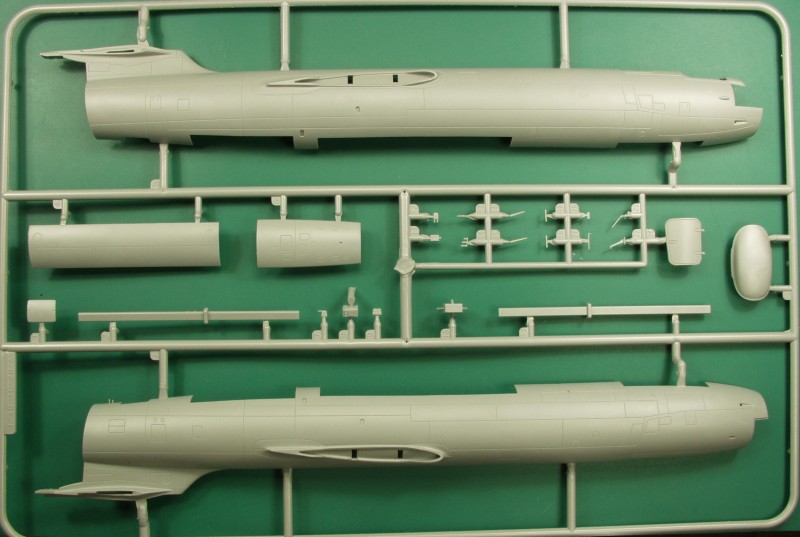
The next sprue has primarily the wing parts.
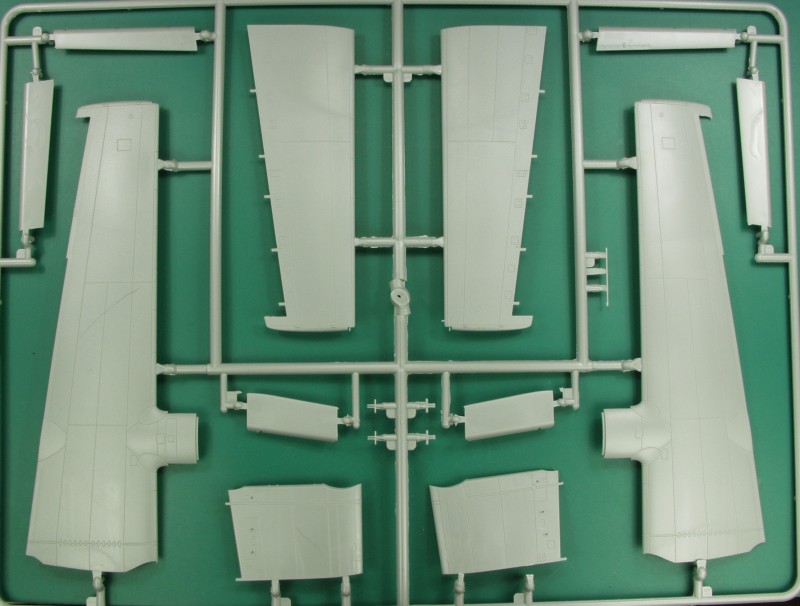
The engines and nacelles.
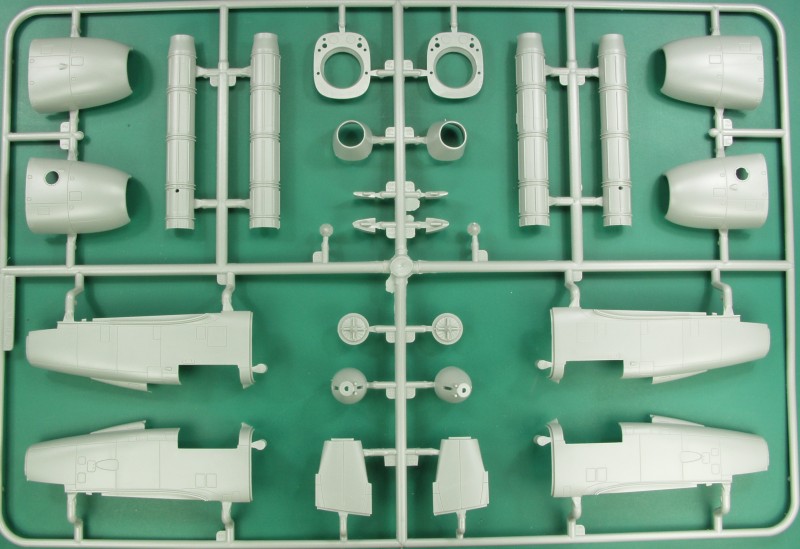
The tail parts, tail turret parts and many of the interior cockpit parts.
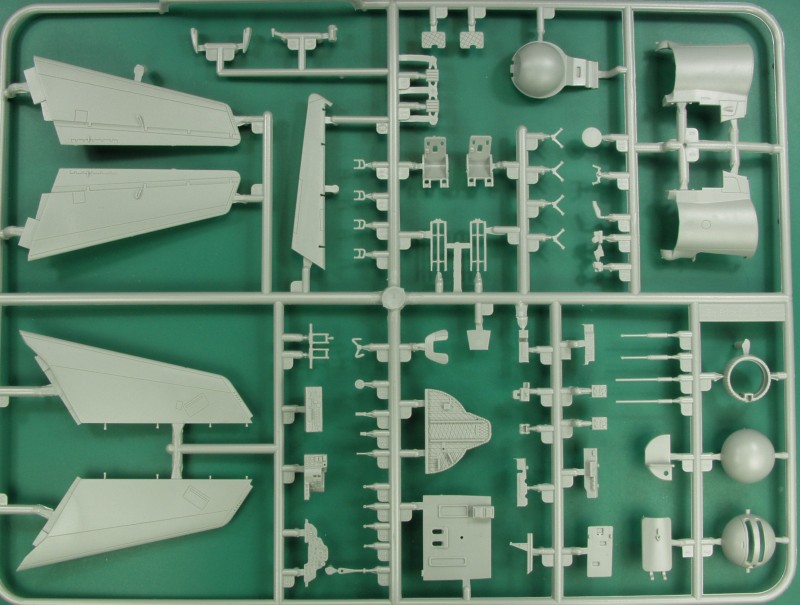
Landing gear parts, open and closed gear doors.
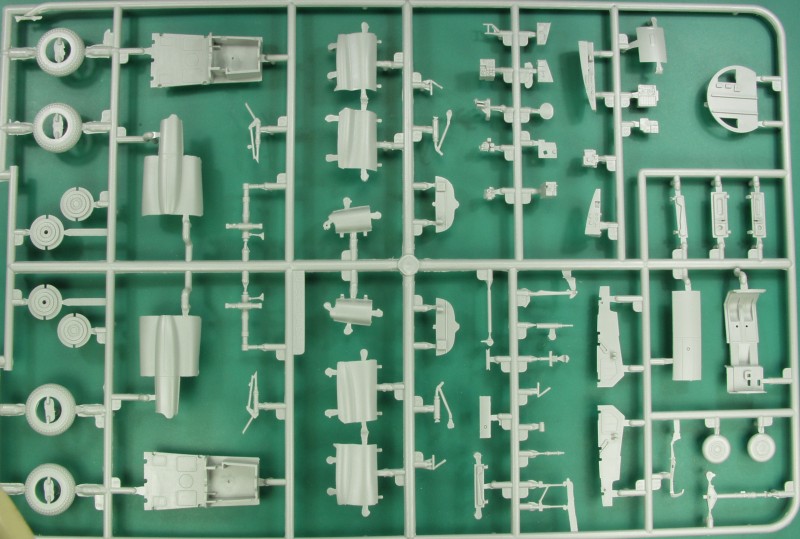
Wing tip tanks, torpedoes, torpedo mounting racks and the radome for the torpedo variant.
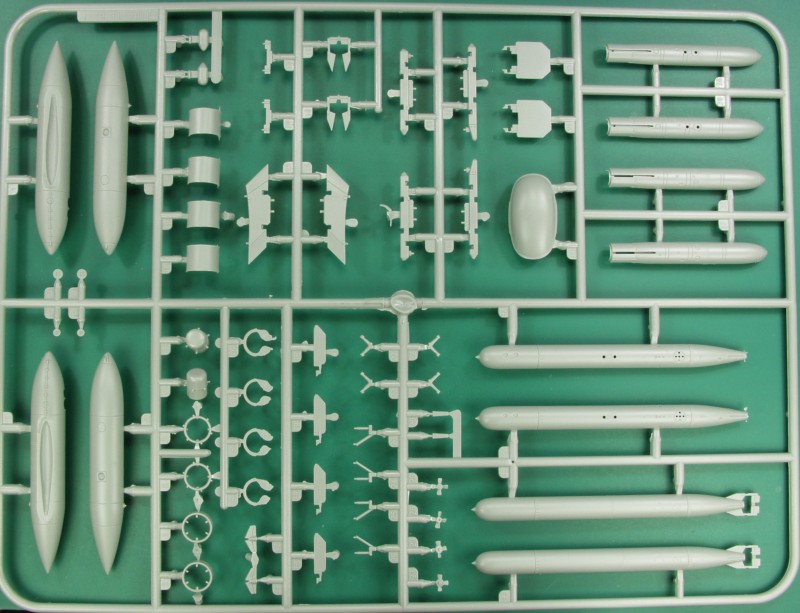
The clear parts are not as thin as those found in many contemporary kits. They are clear enough but have a lot of optical distortion. The main canopy is supplied as either a single piece or with a separate windscreen and side opening section if you want it open. Two different open canopies are supplied but only one is called out. Two nose sections are supplied, one of which is called out and it has a lot more optical distortion than the non specified one and for the life of me I don't see any difference between the two. I find it very frustrating on kits like this that are not that well known to supply parts without more of an explanation of what the optional parts are intended for. The frames are raised which should ease masking tasks, now we just need Eduard to make a mask set for this kit.
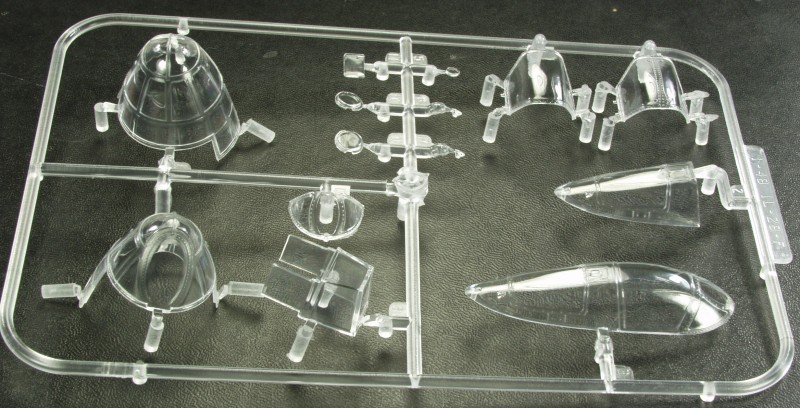
The decals are are glossy in finish, in register and appear sufficiently opaque. They have a bit more excess film than I like to see and there is no information as to where they were printed. I have no experience with decals supplied by Bobcat. Markings are supplied for 6 Soviet aircraft and three Chinese. All but one of these is natural metal with one of the Chinese being OD over gray.
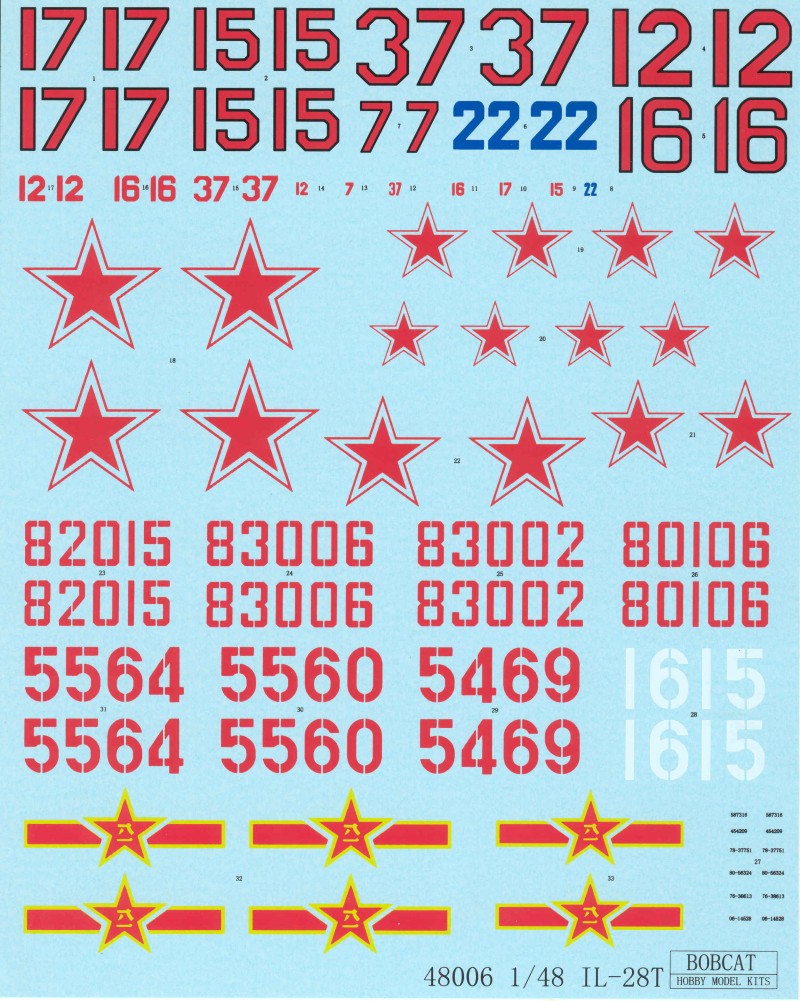
The instructions are in an A4 portrait style booklet, 20 pages long and stapled at the spine. The front page has a halftone print of the box art, a brief history, the usual safety warnings, decal application instructions and an icon chart. The history is only in English but the other stuff is also repeated in Chinese. Page two is a sprue map. Page three has a paint chart giving references for Mr. Hobby, Tamiya and Model Master numbers where applicable. Each color is also called out by name and each color has a letter assigned which is referenced throughout the instructions. The assembly steps begin on the lower half of page 3. The assembly starts with building up sub assemblies, which is the way many modelers like to work anyway. The bomb sight is first, followed by the ejection seats and wing tanks. This continues on page 4 with the nose gear and gear well followed by the two main gear and wells. Page 5 then shows the bomb sight assembly from two perspectives, the assembled nose gear from two perspectives and the main gear assembly from a side view. This is a good check to make certain the gear angles are correct. Also on page 5 is a diagram showing holes that need to be drilled out on the fuselage for the various external munition racks. Page 6 has the main wheel assemblies and assemblies of the two different torpedoes supplied. Page 7 starts with the exterior munition racks then goes through the complete rear fuselage / ball turret assembly. One might want to glue this rear fuselage extension to the main fuselage first to minimize seam work but there is a lot going on inside this section so doing that could be tricky. Page 8 starts the engine and engine pod assembly. They are handed so there are duplicate assemblies for right and left. This continues on to page 9 and from here on things get a bit scatter shot, at least from my perspective. It completes the engine assembly and has you mount one completed assembly to one upper wing half. Also on the page is a small step showing assembly of one of the interior details. Page 10 shows the completion of the basic wing started on the previous page then jumps to building cockpit parts and adding them to the fuselage. Page 11 jumps back to the engine to wing assembly for the other wing. Page 12 goes back to working on the cockpit and interior. Page 13 continues this with an inset showing assembly of the vertical tail. Page 14 finally brings the fuselage together. Page 15 is really busy. The wings get installed as does the tail, rear gun turret and lots of the external fiddly bits which are probably best left till after painting and decal application. Page 16 is equally busy adding all the bits on the underneath side plus the flaps, ailerons and wing tip tanks. Page 17 shows installation of the external munitions. Page 18 has the side profiles of the nine different aircraft for which markings are supplied. And lastly page 19 has top and bottom views for markings. Over all the instructions seem clear enough but the last few pages are really busy and you need to study carefully. Not sure why some of the smaller assemblies were scattered about with other things.
My 2¢ worth
I've waited a long time for a kit of this in 1/48 so I bought this without hesitation. The kit did not disappoint ! Only a build will tell how well it all fits but it certainly looks good in the box and has a very good level of detail. It looks like a main stream kit but I would treat it more as a limited run type and do lots of test fitting. The difficult part will be choosing the markings and studying documentation to determine the proper configuration of the outside details. The Il-28 was to the Communist Block countries what the Canberra and B-57 variants were to the Western Allies. If you want one in this scale this one is your only choice at this time.
As always, thanks for looking !
------------------------------------

History
(From Wikipedia with some changes)
The Ilyushin Design Bureau began development of a new jet-powered tactical bomber in late 1947. The twin-engine Ilyushin Il-28 was created to meet a requirement for a bomber to carry a 6,600 lb bomb load at 500 mph. The new design took advantage of the sale of a number of Rolls-Royce Nene jet engines by Great Britain to the Soviet Union, which allowed Soviet engineers to quickly produce an unlicensed copy of the Nene, the RD-45, with Ilyushin designing the new bomber around two RD-45s.
The Il-28 was smaller than the previous designs and carried a crew of only three (pilot, navigator and gunner). It was also smaller than the competing design from the Tupolev design bureau, the three-engine (i.e. two Nenes and a Rolls-Royce Derwent) Tupolev Tu-73, which had been started long before the Ilyushin project, and flew before the design of the Il-28 was approved.
The Il-28 design was conventional in layout, with high, unswept wings and a swept horizontal tail and fin. The engines were carried in bulky nacelles slung directly under the wings. The nose wheel retracted rearwards, while the main wheels retracted forwards into the engine nacelles. The crew of three were accommodated in separate, pressurized compartments. The navigator, who also acted as bombardier, was accommodated in the glazed nose compartment and was provided with an OPB-5 bomb sight based on the American Norden bomb sight of the Second World War, while the pilot sat under a sideways opening bubble canopy with an armored windscreen. The gunner sat in a separate compartment at the rear of the fuselage, operating a power driven turret armed with two Nudelman-Suranov NS-23 23 mm cannons with 250 rounds each. In service, the turret was sometimes removed as a weight saving measure. While the pilot and navigator sat on ejector seats, the gunner had to parachute out of a hatch in the floor in the event of an emergency. Two more fixed, forward-firing 23 mm cannon with 100 rounds each were mounted under the nose and fired by the pilot, while a bomb bay was located under the wing, capable of holding four 220 lb bombs in individual containers, or single large bombs of up to 6,600 lb slung from a beam in the bomb bay.
One unusual design feature of the Il-28 was that the wings and tail were split horizontally through the center of the wing, while the fuselage was split vertically at the center line, allowing the separate parts to be built individually and fitted out with systems before being bolted together to complete assembly of the aircraft. This slightly increased the weight of the aircraft structure, but eased manufacture and proved to be more economical.
The first prototype, powered by two imported Nenes, made its maiden flight on 8 July 1948, with Vladimir Kokkinaki at the controls. Testing was successful, with the Il-28 demonstrating good handling and reaching a speed of 518 mph. It was followed on 30 December 1948 by the second prototype, with Soviet built RD-45 engines replacing the Nenes. After the completion of state tests in early 1949 the aircraft was ordered into large scale production on 14 May 1949, with the Klimov VK-1, an improved version of the RD-45 to be used in order to improve the aircraft's performance. The first pre-production aircraft with VK-1 engines flew on 8 August 1949, and featured reshaped engine nacelles to reduce drag, while the radome for the navigation radar was moved from the rear fuselage to just aft of the nose wheel.
Full production in three factories started in September 1949, with service deliveries starting in early 1950, allowing 25 Il-28s to be displayed at the Moscow May Day parade of 1950 (as ordered by Joseph Stalin when it was ordered into production in 1949). The Il-28 soon became the standard tactical bomber in the Soviet forces.
The Il-28 was widely exported, serving in the air arms of some 20 nations ranging from the Warsaw Pact to various Middle-Eastern and African air forces. Egypt was an early customer, and targeting Egyptian Il-28s on the ground was a priority for the Royal Air Force during the Suez Crisis and later by the Israeli Air Force during the Six-Day War, and Yom Kippur War. The Soviet Union was in the process of providing the type for local assembly in Cuba when this was halted by the Cuban Missile Crisis, after which Nikita Khrushchev agreed to remove them. The type also saw limited use in Vietnam and with the Afghan forces in Afghanistan. Four ex-Egyptian and two ex-Soviet Il-28s (all with Egyptian crews) were operated by the Nigerian Air Force in the Biafra Wars. Yemeni Il-28s took part in the civil war in that country. Finland also had four examples of this type delivered between 1961 and 1966 for target-towing duties. They remained in service until the 1980s.
The Soviet Union withdrew the type in the 1980s, while the last Soviet-built examples were still flying in Egypt into the 1990s.
The People's Republic of China received over 250 Soviet built Il-28s from 1952, and when the Sino-Soviet split occurred in the late 1950s, it decided to place the Il-28 into production, despite no manufacturing license being obtained. Chinese built aircraft differed from the original Soviet aircraft in that they have a redesigned wing structure, abandoning the horizontal manufacturing break, saving 240 lb at the cost of more difficult construction. Chinese aircraft also used a different tail turret based on that of the Tupolev Tu-16, and fitted with faster firing AM-23 cannon.
Chinese-built Il-28s designated H-5 and built by HAMC were also flying in the 1990s with several hundred in China itself, and a smaller number in North Korea and Romania. The three main Chinese versions are the H-5 bomber, followed by the HJ-5 trainer, and the H-5R (HZ-5) long range (in comparison to the reconnaissance version of Shenyang J-6) reconnaissance aircraft, and later, the HD-5 ECM/ESM version. The latter two types have been phased out.
The type is known to still be in active service with the North Korean Air Force in respectable numbers, although little is known as to whether they are a mix of survivors from the batch of 24 Soviet manufactured aircraft delivered in the 1960s and some of the newer Chinese built H-5 variant, or are solely H-5s. Some of these are probably used for spares to maintain a small group of around a dozen serviceable aircraft. They give North Korea a means of strategically bombing targets in South Korea and Western Japan, although they would be vulnerable to modern anti air missiles and interceptors.
Several Ilyushin Il-28s are preserved in museums and as monuments in Russia, Germany, Hungary and in other countries. Over 6,635 were built.
The Kit
The Bobcat Il-28 comes in a large top open tray type box with a thin cardboard lid and the bottom made from thin corrugated cardboard. The box is filled to the brim with sprues so only a little unused space at each end of the box. There are four large nearly box sized sprues and two slightly smaller ones in gray and a single sprue of clear parts. Each sprue is individually wrapped in resealable cellophane bags. Finishing off the contents is a large sheet of decals and the instruction booklet. While the kit is labeled as a torpedo bomber, all the parts needed for a standard bomber are included in the kit. The parts are molded in light gray and feature recessed panel lines and fastener details. We are spared from the mad riveter on this one as the only fasteners are those on access panels. Some raised details are provided where applicable. The surface has a matte finish and there is a small amount of flash present but not so much as to be a concern. Mold alignment is good with only minimal seam lines to clean up. The sprue attachment points are quite heavy on many of the parts, especially the larger ones and I would recommend sawing these off rather than using sprue cutters. The molding is sharp and clean and the panel lines are consistent and uniform. I did not find any surface defects or sink marks on my kit. Ejector pin marks appear to have been kept away from visible areas. I did find a couple on the main gear struts but these will not be all that easy to see once assembled.
Starting with the fuselage there is a lot of nice detail included in the box. First off there are a lot of holes that need to be opened before assembly for the external stores so you need to decide before hand what you intend to use. From the pilots position forward the fuselage is packed with details, consoles, panels and other equipment. The bulkhead behind the pilot features a simulated pleated effect. The instrument panel just has recesses for the instruments as well as some raised details and the back side has the instrument cases represented. No decals are supplied for the instrument panel or any of the other panels so hopefully Eduard will bless us with some photo etch for these. Many of the small knobs and levers supplied will quite honestly be very difficult to remove from the sprues and clean up let alone handle for assembly. The front office will be quite busy when complete. No harnesses are supplied for the ejection seats. The rear turret area is also very well detailed. Although the kit is intended to represent the torpedo variant a shallower radome used on the standard bomber version is supplied but not mentioned in the instructions. Due to the length of service of this aircraft, the total number built and the large number of countries that operated it, a good reference will be necessary if you want to create an accurate specific version. The bomb bay doors are supplied as separate pieces in the closed position. As there is no bomb bay detail in this kit that makes sense. Maybe a future kit will provide that. The forward bomb bay door section provides a place to use a stand by cutting an opening and adding a strengthening piece on the inside but no stand is supplied.
Moving on to the wings they are molded with a half span top piece with the bottom half split with sections inboard and out board of the engine pods. Ailerons and flaps are molded separately. As with the fuselage there are holes that need to be opened depending on version being modeled. There are two spars that are inserted in the fuselage prior to assembly that should provide solid support for the wings. Wing tip tanks are provided but these can be left off for versions other than the torpedo bomber. The engine pods are divided into front and rear sections divided just ahead of the landing gear bays. Being the skeptic that I am I would think gluing the front and rear portions together first would be a better way to avoid seam issues but I guess time will tell. The forward section has a clear inspection port and the engine nose cone and vanes. The rear portion contains the main gear bay and engine. The engine is pretty featureless with a turbine blade front and and hollow rear portion. Nothing but those parts will be seen so it's not an issue as there is no option to display the engines. The main gear bays as well as the nose gear bay are very well detailed with separate actuation struts and cylinders and torque links. The roof of the bay has raised rivet detail and some additional parts are added to partially box in the area. The main gear wheels are molded in halves and feature a very nice looking block tread detail. Unfortunately one will need to deal with a seam down the middle of them. The hubs are separate for easier painting. The nose gear wheel is in halves with radial tread and the hub is molded as part of the wheel. The tires are not weighted. The main gear doors have some nice recessed detail and raised rivet detail. The gear doors are also supplied as one piece closed doors if you wish the gear retracted.
The one piece horizontal stabilizers have the elevators molded in the neutral position and have a nice deep demarcation for elevators. The vertical tail is molded in halves as a separate piece rather than being molded as part of the fuselage. The rudder is molded separately in one piece.
There are two different style torpedoes supplied, a conventional type which is quite well detailed and a rocket powered torpedo. There is a plethora of small antennas and other protrusions to be added to the fuselage once it is assembled.
Lets look at the sprues... The first one has the fuselage halves, bomb bay doors, crew hatch, wing spars, some of the external antennas and the standard bomber radome.

The next sprue has primarily the wing parts.

The engines and nacelles.

The tail parts, tail turret parts and many of the interior cockpit parts.

Landing gear parts, open and closed gear doors.

Wing tip tanks, torpedoes, torpedo mounting racks and the radome for the torpedo variant.

The clear parts are not as thin as those found in many contemporary kits. They are clear enough but have a lot of optical distortion. The main canopy is supplied as either a single piece or with a separate windscreen and side opening section if you want it open. Two different open canopies are supplied but only one is called out. Two nose sections are supplied, one of which is called out and it has a lot more optical distortion than the non specified one and for the life of me I don't see any difference between the two. I find it very frustrating on kits like this that are not that well known to supply parts without more of an explanation of what the optional parts are intended for. The frames are raised which should ease masking tasks, now we just need Eduard to make a mask set for this kit.

The decals are are glossy in finish, in register and appear sufficiently opaque. They have a bit more excess film than I like to see and there is no information as to where they were printed. I have no experience with decals supplied by Bobcat. Markings are supplied for 6 Soviet aircraft and three Chinese. All but one of these is natural metal with one of the Chinese being OD over gray.

The instructions are in an A4 portrait style booklet, 20 pages long and stapled at the spine. The front page has a halftone print of the box art, a brief history, the usual safety warnings, decal application instructions and an icon chart. The history is only in English but the other stuff is also repeated in Chinese. Page two is a sprue map. Page three has a paint chart giving references for Mr. Hobby, Tamiya and Model Master numbers where applicable. Each color is also called out by name and each color has a letter assigned which is referenced throughout the instructions. The assembly steps begin on the lower half of page 3. The assembly starts with building up sub assemblies, which is the way many modelers like to work anyway. The bomb sight is first, followed by the ejection seats and wing tanks. This continues on page 4 with the nose gear and gear well followed by the two main gear and wells. Page 5 then shows the bomb sight assembly from two perspectives, the assembled nose gear from two perspectives and the main gear assembly from a side view. This is a good check to make certain the gear angles are correct. Also on page 5 is a diagram showing holes that need to be drilled out on the fuselage for the various external munition racks. Page 6 has the main wheel assemblies and assemblies of the two different torpedoes supplied. Page 7 starts with the exterior munition racks then goes through the complete rear fuselage / ball turret assembly. One might want to glue this rear fuselage extension to the main fuselage first to minimize seam work but there is a lot going on inside this section so doing that could be tricky. Page 8 starts the engine and engine pod assembly. They are handed so there are duplicate assemblies for right and left. This continues on to page 9 and from here on things get a bit scatter shot, at least from my perspective. It completes the engine assembly and has you mount one completed assembly to one upper wing half. Also on the page is a small step showing assembly of one of the interior details. Page 10 shows the completion of the basic wing started on the previous page then jumps to building cockpit parts and adding them to the fuselage. Page 11 jumps back to the engine to wing assembly for the other wing. Page 12 goes back to working on the cockpit and interior. Page 13 continues this with an inset showing assembly of the vertical tail. Page 14 finally brings the fuselage together. Page 15 is really busy. The wings get installed as does the tail, rear gun turret and lots of the external fiddly bits which are probably best left till after painting and decal application. Page 16 is equally busy adding all the bits on the underneath side plus the flaps, ailerons and wing tip tanks. Page 17 shows installation of the external munitions. Page 18 has the side profiles of the nine different aircraft for which markings are supplied. And lastly page 19 has top and bottom views for markings. Over all the instructions seem clear enough but the last few pages are really busy and you need to study carefully. Not sure why some of the smaller assemblies were scattered about with other things.
My 2¢ worth
I've waited a long time for a kit of this in 1/48 so I bought this without hesitation. The kit did not disappoint ! Only a build will tell how well it all fits but it certainly looks good in the box and has a very good level of detail. It looks like a main stream kit but I would treat it more as a limited run type and do lots of test fitting. The difficult part will be choosing the markings and studying documentation to determine the proper configuration of the outside details. The Il-28 was to the Communist Block countries what the Canberra and B-57 variants were to the Western Allies. If you want one in this scale this one is your only choice at this time.
As always, thanks for looking !
------------------------------------
